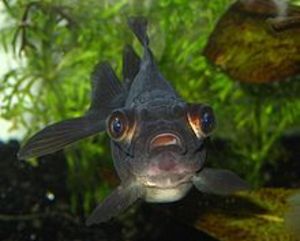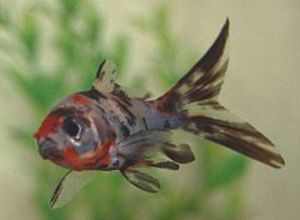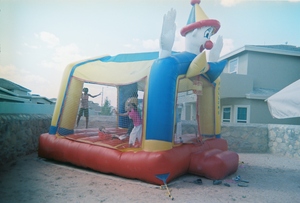Black moor goldfish are the most popular goldfish with an egg-shaped or nearly round-shaped body. Usually fan-tails or egg-shaped goldfish cannot swim very well and are at a distinct disadvantage when placed in a tank with long-bodied goldfish like the common, comet or shubunkin. The long-bodied fish are faster swimmers and can gobble up the food before the slower swimmers get any chance at it.
However, black moors, especially juvenile black moors, are surprisingly good swimmers and can usually hold their own against longer-bodied goldfish. If the black moor grows to a spectacular size of 10 inches across, then it will need to be placed in a tank of slower swimmers. If the individual black moor is prone to swim bladder problems, then it also needs to be in a tank with slow swimmers.
Those Eyes
Black moors are a type of goldfish called telescoping goldfish, which is a polite way of saying “googly-eyed.” The black moor’s eyes stick noticeably out of the sides of the fish’s head. They can be moved individually which can make the black moor appear at times to be a fishy mantis, or a goldfish that is wearing miniature goggles. In Asia, black moors may be called “dragon eye fish.”
Unfortunately, protruding eyes bump into objects like plants, rocks or decorations. This can cause injuries to the eyes that can eventually kill the fish. Anyone considering a black moor needs to have a tank free of any sharp points. Some people even go so far as to keep a tank completely bare of gravel, plants or ornaments. But black moors seem to enjoy rooting about in gravel and do like a place to hide.
Coloration
Most goldfish change colors over the course of their lives. This is also true of black moors, although their color changes are far more predictable than for a common or comet goldfish. Juvenile black moors, which is what are mostly found in pet stores, are a velvety black with faint bronze highlights.
As the fish matures, these bronze highlights become more and more pronounced. The bell and sides become a bronze or metallic orange color. The eyes and fins tend to stay black.
There is a rare variation called panda moors which are mostly white with black fin edges and dorsal stripe. They also can grow to be 10 inches across and are as susceptible to eye injuries as a black moor.
Other Tips
Unlike long-bodied goldfish, black moors must be kept in aquariums and not ponds. They are peaceful with other goldfish but will eat a dead one if given the opportunity. Immediately after spawning, the parents and any other tank mates begin eating the fertilized eggs. Like other goldfish varieties, they produce a lot of waste and so weekly partial water changes and ammonia tests of the tank water are a must.
References:
“Goldfish: A Pet Owner’s Manual.” Marshall Ostrow. Barron’s; 1995.
“Goldfish.” Bernice Brewster and Nick Fletcher.” Bow Tie Press; 2004.
Black Moor Goldfish.com. “Important Facts about the Black Moor Goldfish.” ttp://blackmoorgoldfish.com/important-facts-about-the-black-moor-goldfish/
Personal experience



